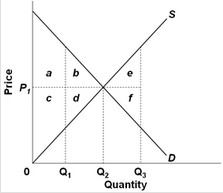Your boss gives you an increase in the number of dollars you earn per hour. This increase in pay makes
a. your nominal wage increase. If your nominal wage rose by a greater percentage than the price level, then your real wage also increased.
b. your nominal wage increase. If your nominal wage rose by a greater percentage than the price level, then your real wage decreased.
c. your real wage increase. If your real wage rose by a greater percentage than the price level, then your nominal wage also increased.
d. your real wage decrease. If your real wage rose by a greater percentage than the price level, then your nominal wage decreased
Answer: a. your nominal wage increase. If your nominal wage rose by a greater percentage than the price level, then your real wage also increased.
You might also like to view...
Use the figure below to answer the following question. The area that identifies the maximum sum of consumer surplus and producer surplus is
The area that identifies the maximum sum of consumer surplus and producer surplus is
A. a + b + e. B. a + b + c + d. C. a + b + c + d + e + f. D. c + d + f.
One reason why consumers are unlikely to be too upset about tariffs is because
A) most consumers benefit from protection. B) tariffs are an inexpensive way to create jobs. C) consumer losses are not real losses. D) the costs are so spread out that no one pays a big share of the total. E) the gains of producers are larger.
Stock prices change when
A) expectations are based on past performance B) expectations change. C) accounting profits are zero. D) none of these choices.
Draw a profit/price trade-off curve that is the result of moving from a competitive to a monopoly industry organization. Show the equilibrium position for the regulator with a political support function (PS curve). What can we say about prices and profits of the regulated industry if it started as a competitive industry?
What will be an ideal response?